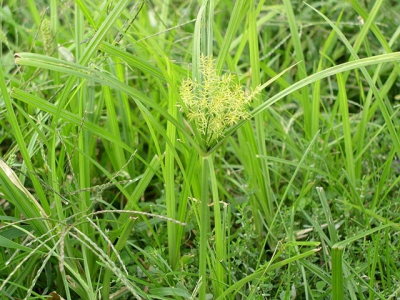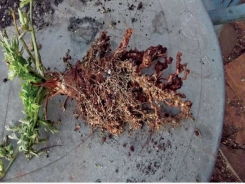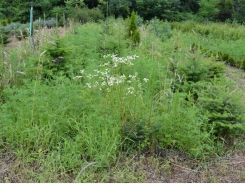Coping with nutsedge

Officially, the world’s number one weed is nutgrass, more correctly called ‘nutsedge’, as it’s not a grass but a sedge. (Sedges don’t have nodes as do true grasses.)
The shorter, darker plants on the left are red nutsedge, while the lighter, taller ones on the right are yellow nutsedge.
It’s also often referred to as ‘watergrass’ due to its ability to thrive in wet conditions. There are two main species: yellow nutsedge (Cyperus esculentus) and purple or red nutsedge (Cyperus rotundus). Although the species are sometimes confused, they have very different properties. Yellow nutsedge’s leaves are larger and lighter in colour. The flower is also yellow, which is the easiest way to tell the species apart.
Red nutsedge has a purple or reddish colour, the plant is shorter and the leaves a darker green. Colour differences can also be seen on the tubers. Yellow nutsedge is lighter coloured and more rounded than the elongated tubers of red nutsedge, which are also darker in colour. It’s important to know which species you’re dealing with, as the control measures differ.
Yellow nutsedge is far more common. It survives regular cultivation and may even thrive on it. The red species doesn’t like regular cultivation, and this can be a means of eradication. On the other hand, red nutsedge is extremely difficult to eradicate with herbicides, whereas the yellow species can be successfully controlled with these. I’ve applied repeat applications of Roundup (glyphosate) to the red nutsedge and only managed to get a little scorch. It quickly bounces back.
Allelopathy
The need to control nutsedge goes far beyond preventing competition for nutrients and water in crops. These sedges also produce biochemicals, which enter the surrounding soil and suppress the growth of other species. Called allelopathy, this mechanism gives nutsedge a better chance to thrive when in competition with other species.
And you may have noted that, in a land where the crop is infested with a number of different weed species, the crop in the area where nutsedge grows is far more suppressed than where other weeds are growing. This will be so, even when the other weeds are taller and remove more water and nutrients from the soil.
Autotoxicity
Interestingly, there is a similar phenomenon which works the opposite way. With autotoxicity, the exudates affect the same species, so seeds from the species can’t germinate nearby. This prevents the stand from becoming so dense that the original plants aren’t able to grow strong enough to produce a deep root system and in so doing reduce the capacity of the plants to survive under drought stress. Crops which exhibit this trait are lucerne and Eragrostis curvula.
Persistence
Back to nutsedge. You can eradicate this weed with planning and persistence. It is very damaging and it really is best to ‘bite the bullet’ and come up with a strategy to get it under control. Your pest control agent will be able to help with this task.
However, if you have a bad infestation of C. esculentus, allow it to start going to seed, and then apply a split application of glyphosate four days apart. A further application may be necessary in some cases.
And you can even spot spray with a knapsack later if individual plants reappear. It’s important to persist once you’ve started the process. Rest assured, these weeds can be eradicated. You also need to select follow-up crops to help the process.
There are herbicides which can be used for brassicas, beans and so on, which are effective in keeping this weed down.
But don’t plant a tall crop where nutsedge can grow and multiply unseen beneath the canopy. To re-iterate, control requires a concerted effort, usually with the help of a knowledgeable crop pest control representative.
Tools

Phối trộn thức ăn chăn nuôi

Pha dung dịch thủy canh

Định mức cho tôm ăn

Phối trộn phân bón NPK

Xác định tỷ lệ tôm sống

Chuyển đổi đơn vị phân bón

Xác định công suất sục khí

Chuyển đổi đơn vị tôm

Tính diện tích nhà kính

Tính thể tích ao



 The Coolest Cucumber You’ve Never Met
The Coolest Cucumber You’ve Never Met  Watch out for weeds
Watch out for weeds